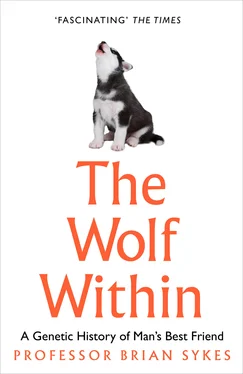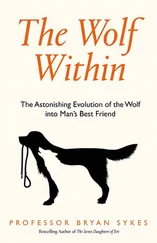The Wolf Within is primarily a book about the evolution of dogs and the forces that drove this astonishing transformation from a fierce and wild carnivore to the huge range of comparatively docile animals that is the domesticated dog. It is also about the other side of the equation, how it was that our own species Homo sapiens , an equally aggressive carnivore, formed such a special relationship with what, on the face of it, is a most unlikely ally. The Wolf Within contends that this is more than just a story of the subjugation of one species by another but a shining example of the co-evolution of two species to each other’s mutual benefit. Indeed, I conclude that this co-evolution was one of the vital steps in helping Homo sapiens gain the upper hand in the competition with other human species, such as Neanderthals, and to expand in numbers from relative obscurity towards the overwhelming numerical superiority and influence that we enjoy today.
The scientific substance of the book draws on the rich detail of the genomes of both dog and human that has accumulated over the past two decades. Thanks to these advances we are able to make out clear patterns in the distant origins of both species, resolving questions that have puzzled scientists for over two centuries. I also explore the history and practice of breeding and its influence on the health and the welfare of pedigree dogs. In parallel, I explore the breadth of this ‘special relationship’ between man and dog, including interviews with the owners of many different breeds, as well as the lengths some will go to immortalise their favourite pet through cloning.
As I mentioned a few pages back, we think nothing of seeing a dog and its owner walking together along the street, yet how did this everyday scene ever come about? We have long suspected that dogs descend from wolves. We know that the distant ancestors of today’s dogs formed close bonds with us a long time ago and there is a multitude of theories to account for our compatible social organisations. To a geneticist like myself, none of these is anywhere near enough to explain this most peculiar situation. In the harsh world of natural selection, only advantageous traits are conserved from one generation to the next.
Many owners who were interviewed for this book are fulsome in praise of their dog’s loyalty and companionship. That may well be true today, but it is grossly inadequate to explain the rise of the dog at a time in our evolution when we were living on the edge of starvation with no time for luxuries. No, there must have been a compelling evolutionary advantage in keeping a dog, not least to offset the extra demands of feeding it.
There is another question that requires an answer. Domestication (a wholly inaccurate phrase in my opinion but which will do for now) occurred at a time when all humans were both hunters and gatherers, but mainly hunters. In this respect their way of life had not changed a great deal for at least 200,000 years. There were plenty of wolves, hyenas, jackals and foxes about which could have formed the ancestral stock for the dog – and yet there is no evidence of ‘domestication’ until 50,000 years ago at the outside.
Many theories seek to explain what it was that propelled Homo sapiens from a scarce, medium-sized primate to the position of complete domination that we enjoy today. The ability to control fire, the evolution of language and the invention of agriculture are three prominent examples. I would add a fourth: the transformation of the wolf into the multi-purpose helpmate and companion that is the dog. We owe our survival to the dog. And they owe theirs to us.
1
At its narrowest point, the mighty Danube thunders through a narrow gorge, the Gate of Trajan, *cut by the river into the limestone bastions of the Carpathian Alps. Lupa, the she-wolf, stood at the edge of the gorge gazing down at the small figures making their way up the banks of the river a hundred metres below. They did not provoke in her any particular reaction. Humans had been using the river in this way for as long as she could remember. She and her pack did not have anything to do with the humans, but all the same she liked to keep an eye on them when they were in her territory. She knew the humans as brave hunters but they moved far too slowly to be very effective. They would eat anything that moved, including her fellow wolves if they could catch one. But that very rarely happened, and only if a wolf was sick or injured in some way. Earlier in the year, Lupa had watched the humans ambush and kill a young mammoth by driving it over the edge of the cliff, though this was unusual and most of the time they seemed barely able to scrape a living. For Lupa the main thing was to leave them alone and avoid unnecessary confrontations.
As the river mist lifted with the first rays of morning sun, Lupa could see the humans more clearly and, with her acute awareness of every detail of her surroundings, she sensed that they were a bit different from usual. They were a little taller, a little slimmer perhaps and moved a little more, how would she put it, a little more gracefully . Probably nothing in it, she thought to herself. Even so, I’ll keep a close eye on them. She turned away and trotted effortlessly back across the undulating grassland, dusted by an early frost, to join the rest of the pack. It was October and winter was well on the way. The river had begun to freeze over and the last of the reindeer had already moved down from the high plateau to their wintering grounds on the river estuary. It was time for Lupa and her pack to follow them, and next day she led them on the long trek downstream towards the Great Black Sea.
Along with Lupa and her mate of two seasons there were four young wolves in Lupa’s pack, two from this year’s litter and two from the year before. The pups, born in June, were just old enough to learn to hunt. Before that the pack was too small to be viable for long and it had been hard work getting enough food over the summer. As always, it was Lupa who organised the hunting. She decided what prey to target, even which animal to go for. She planned the chase to take advantage of any variation in the contours of the landscape and decided where to set any ambushes. The pack was completely dependent on her skill and leadership.
Meanwhile, the humans at the bottom of the gorge were not aware that they were being watched. They knew about wolves, of course. They occasionally came across one in the forests and were familiar with the eerie howling that kept pack members in touch with one another. But in general humans and wolves kept themselves to themselves. The new type of human, Homo sapiens , that Lupa had seen from her vantage point at the lip of the gorge had other things on their mind. The first of these was that the gorge was also home to Neanderthals. They were noticeably different in appearance, being much heavier set and therefore stronger, but at the same time were less agile. Neanderthals and moderns tolerated each other and, in fact, occasionally interbred. The biggest difference between the two human species was invisible. The Neanderthals were not as smart or inventive. They hadn’t changed their hunting methods or equipment for at least 200,000 years and showed little sign of ever doing so. The moderns on the other hand were always thinking of new ways of doing things. New designs of stone tools, of bows and arrows, the invention of the atlatl, or spear-thrower, and of all sorts of personal adornments. In time, these improvements would spell the end of the Neanderthals, and now there was one other innovation that was about to make an impact, a coalition between wolf and human, something the Neanderthals had never even contemplated.
The caves lining the Gate of Trajan were a favourite hibernation site for one of the most feared animals of the Upper Palaeolithic, the cave bear Ursus spelaeus , half as big again as the brown bear and with a voracious, omnivorous appetite for food which, from time to time, included humans, both Neanderthal and modern. Whereas Neanderthals abandoned the shelter of the caves as soon as they heard or smelled a bear nosing around, moderns had learned to leave the caves in the autumn and return a few weeks later when the bears were hibernating and kill them where they slept. This gave them vacant possession and enough meat to help them through the winter, should they wish to stay.
Читать дальше












